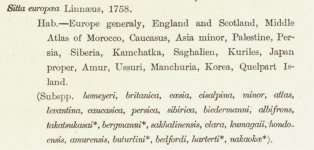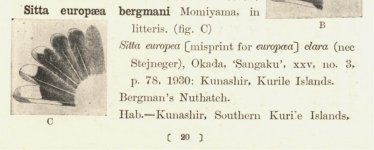Björn Bergenholtz
(former alias "Calalp")

Quick return ...
Now I´ve checked Bergman's paper in Arkiv för Zoologi (it´s all in English!), and as the title indicates (New Birds from the Kurile Islands), there´s nothing on any Nuthatch ... in my mind, simply due to the fact that any possible Nuthach seen (or caught) on those Islands wasn´t "New", not in Bergman's view, That was the opinion of Mr Momiyama.
Ok, so that paper was a Dead End. But I´m still not all convinced we will have to finally agree with Dickinson et al, that the type/s of the bergmani Nuthatch truly was (or is): "Lost".
In the Introduction of this paper Bergman explains:
Thereby; as of now, my last hope to find it lays in the hands of NRM (Naturistoriska riksmuseet), here in Stockholm. I´ve asked the Curator to have a look in their collections, to keep an eye open for any Sitta europaea ssp., collected in 1929-1930, marked with either; "Kurilerna" (in Swedish, alt. "Kuril/e/s") or "Yetorofu", as the location, on the specimen label/s.
We´ll see what he can find!
Björn
PS. Either way; one cannot but wonder if any of those duplicates are still kept, still waiting to be found, in the YIO collection (there are a few possible candidates).
--
Now I´ve checked Bergman's paper in Arkiv för Zoologi (it´s all in English!), and as the title indicates (New Birds from the Kurile Islands), there´s nothing on any Nuthatch ... in my mind, simply due to the fact that any possible Nuthach seen (or caught) on those Islands wasn´t "New", not in Bergman's view, That was the opinion of Mr Momiyama.
Ok, so that paper was a Dead End. But I´m still not all convinced we will have to finally agree with Dickinson et al, that the type/s of the bergmani Nuthatch truly was (or is): "Lost".
In the Introduction of this paper Bergman explains:
Maybe, among those 1100 birds, there might be a Nuthatch. Even if not "New", in Bergman's view. Who knows?"During my expedition to the Kurile Islands 1929-1930 for the purpose of zoological exploration, I collected [...], a number of some 1100 birds. These birds are now in the possession of the Natural History Museum, Stockholm, to which I have presented the collection together with all the other zoological material from the expedition, except a duplicate collection of birds reserved for Japan."
Thereby; as of now, my last hope to find it lays in the hands of NRM (Naturistoriska riksmuseet), here in Stockholm. I´ve asked the Curator to have a look in their collections, to keep an eye open for any Sitta europaea ssp., collected in 1929-1930, marked with either; "Kurilerna" (in Swedish, alt. "Kuril/e/s") or "Yetorofu", as the location, on the specimen label/s.
We´ll see what he can find!
Björn
PS. Either way; one cannot but wonder if any of those duplicates are still kept, still waiting to be found, in the YIO collection (there are a few possible candidates).
--
Last edited:






